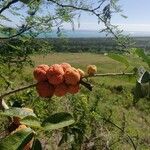Erect or climbing shrub to woody climber; twigs lenticellate, glabrous; spines curved, to 1.5 (–2.5) cm long. Leaves: lamina elliptic, rarely ovate to obovate, (2.5–) 4–10 cm long, 1.5–2.5 cm wide, cuneate or obtuse at base, entire margin, acute to apiculate at apex, glabrous; lateral veins 7–10 pairs; petiole 0.3–2 cm long; stipules to 2 mm long, fulvous. Inflorescences paired, shorter than leaves. Male inflorescences 5–10 mm diam.; peduncle 5–8 mm long; flowers c. 1.5 mm long, obpyramidal; tepals 4, spathulate, concave at apex, pubescent; stamens 4; pistillode subulate. Female inflorescence slightly larger than male; flowers sessile, ± obconical, c. 1.5 mm long and wide; tepals 4, rarely 3, lightly pubescent. Syncarp 1.5–2 cm wide. Achenes obovoid to nearly globular, ± compressed, to 8 mm long and 6 mm wide, partially immersed in receptacle.
Shrubs, erect or scandent. Branches glabrous; spines curved or straight, to ca. 2 cm, sometimes very inconspicuous. Petiole ca. 1 cm; leaf blade elliptic-lanceolate to oblong, 3-8 × 2-2.5 cm, papery to leathery, glabrous, base cuneate, margin entire, apex rounded to shortly acuminate; secondary veins 7-10 on each side of midvein, tertiary veins reticulate. Male inflorescences a capitulum, 6-10 mm in diam., pedunculate. Female inflorescences pubescent; peduncle to 1 cm. Male flowers: calyx lobes 4, unequal; anthers short; pistillode pyramidal or shield-shaped. Female flowers: calyx lobes free or basally connate, apex thick. Fruiting syncarp reddish orange when mature, 2-5 cm in diam., pubescent. Drupes brown when mature, ovoid, smooth. Fl. Apr-May, fr. Jun-Jul.
A thorny climbing shrub. It grows 4-10 m long. It has cane like twigs. It forms thickets. It can be erect or spreading. It has spines which are curved. They are about 1 cm thick. The leaves are alternate and oblong. The base is wedge shaped and it tapers to a short tip. They are 7-15 cm long and 3-5 cm wide. The leaf stalk is 6-10 mm long. They are leathery. Broken leaves and twigs ooze milky sap. The male and female flowers are separate on separate plants. The male flowers are 6-10 mm wide. The female flowers are hairy. The fruit is a composite round fruit 2-5 cm across. It has a pattern of squares over the surface and is green but turns yellow-orange when mature. They are hairy. The fruit are edible. There are several very small seeds inside.

